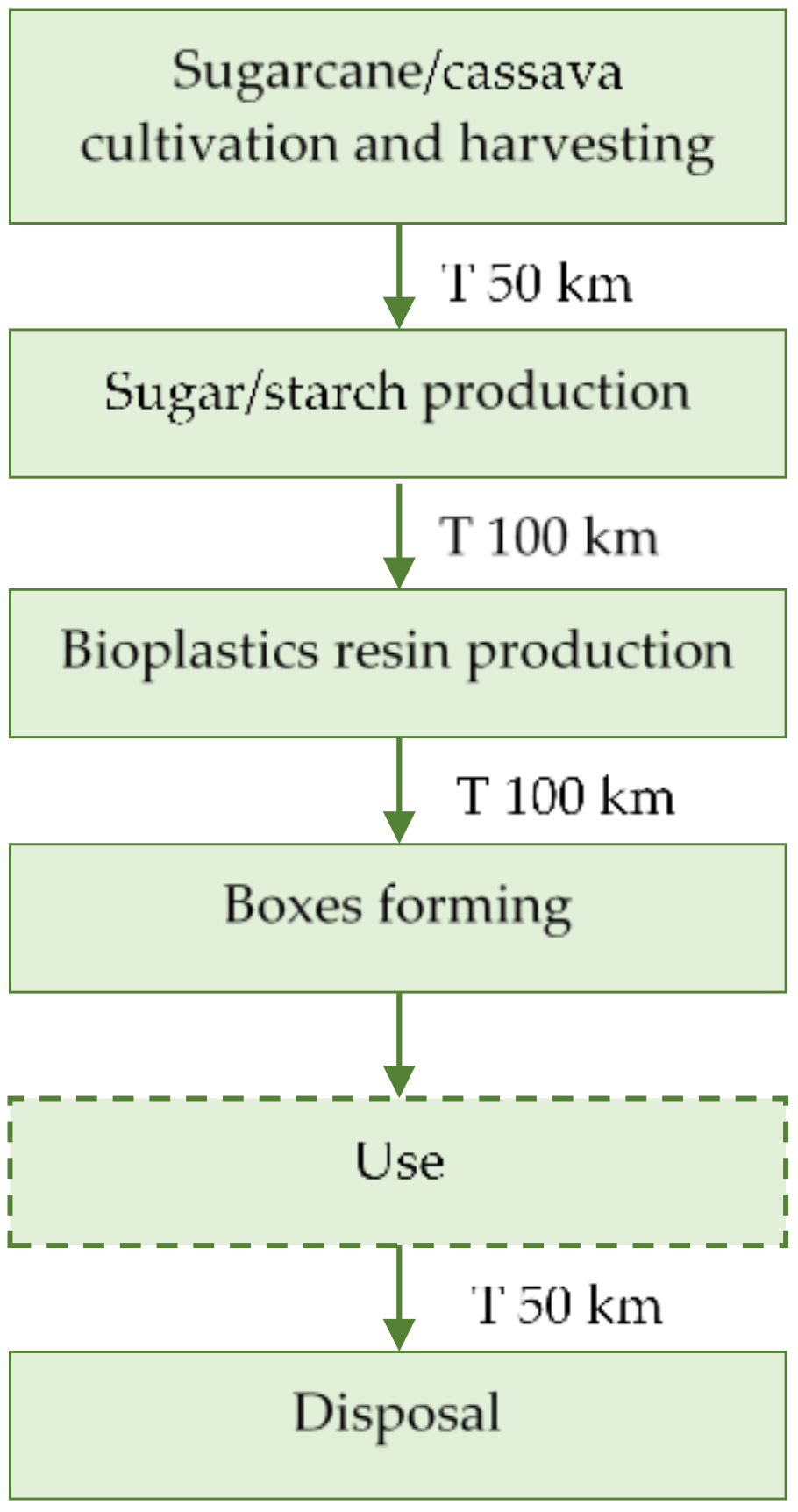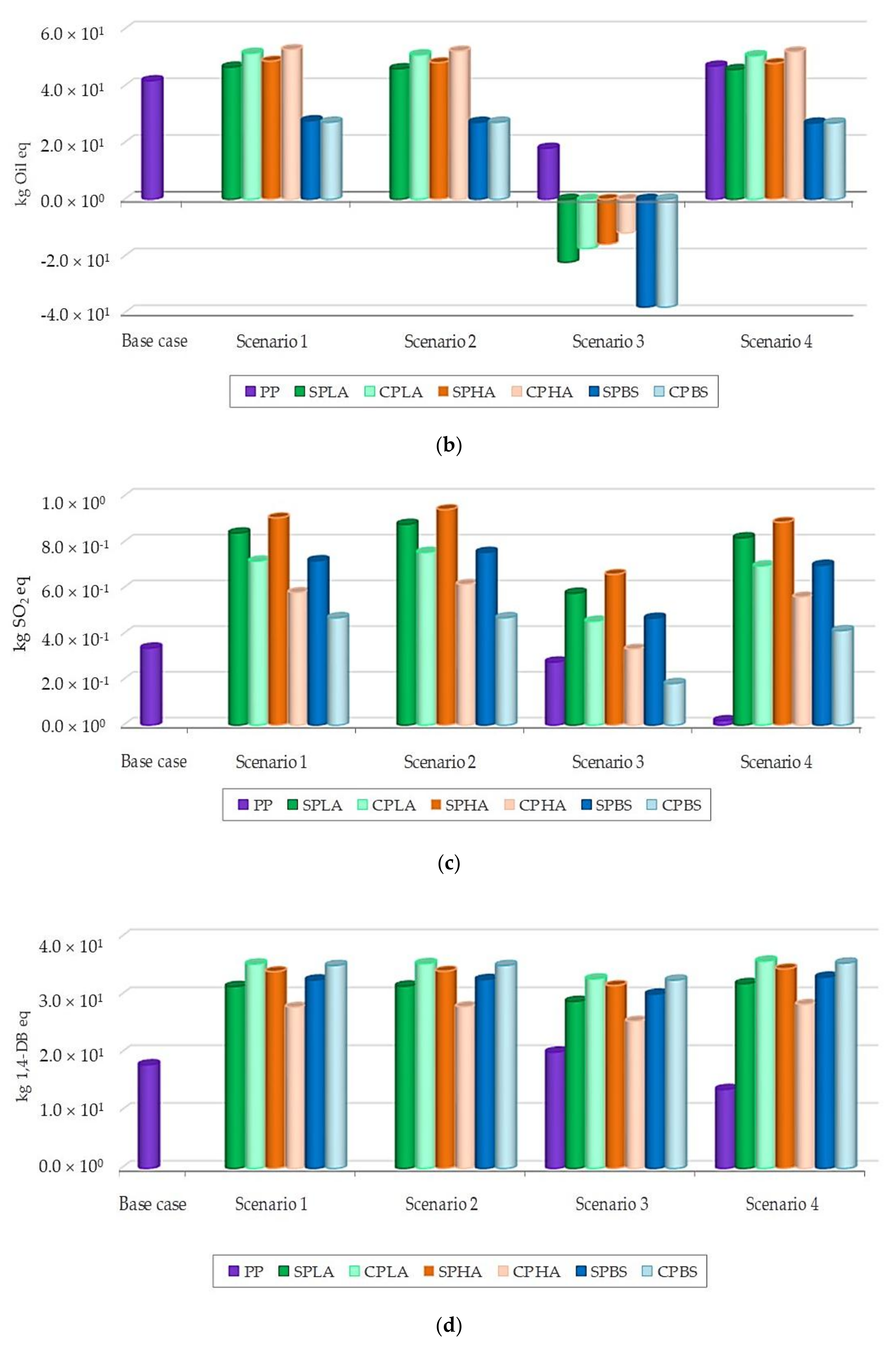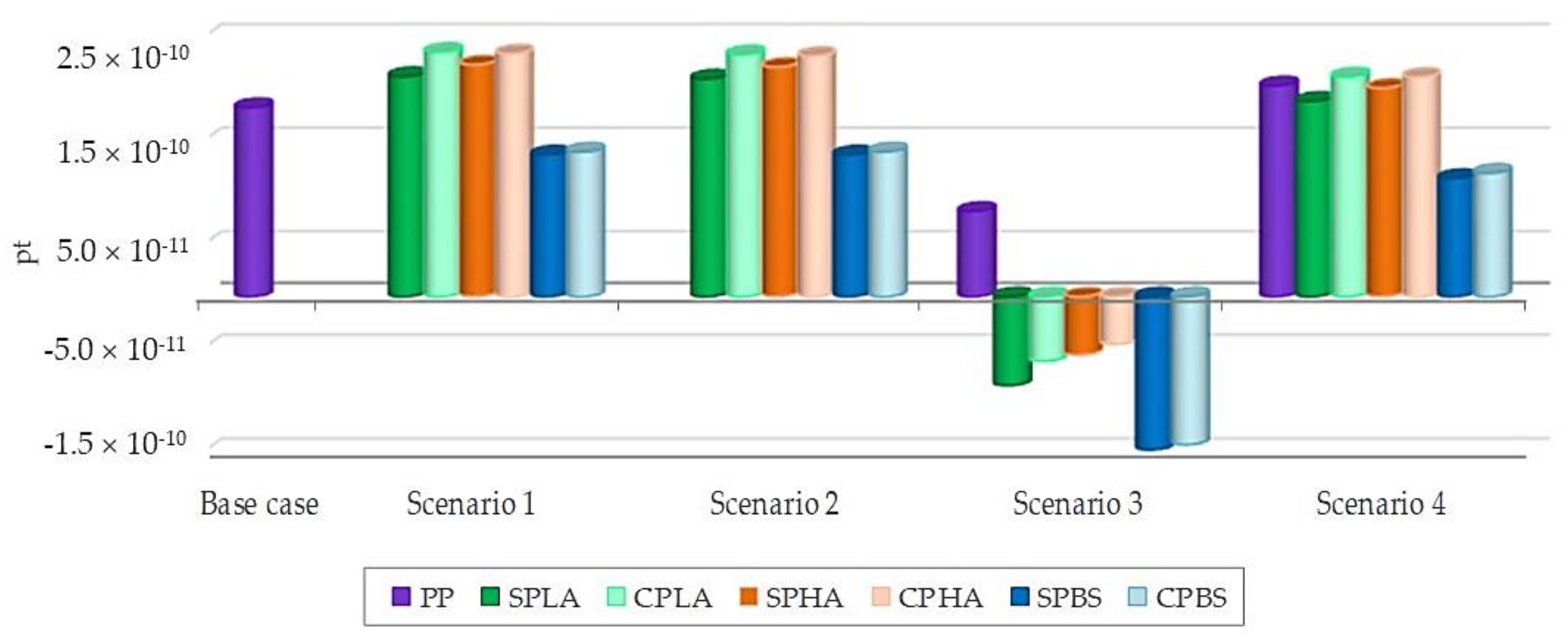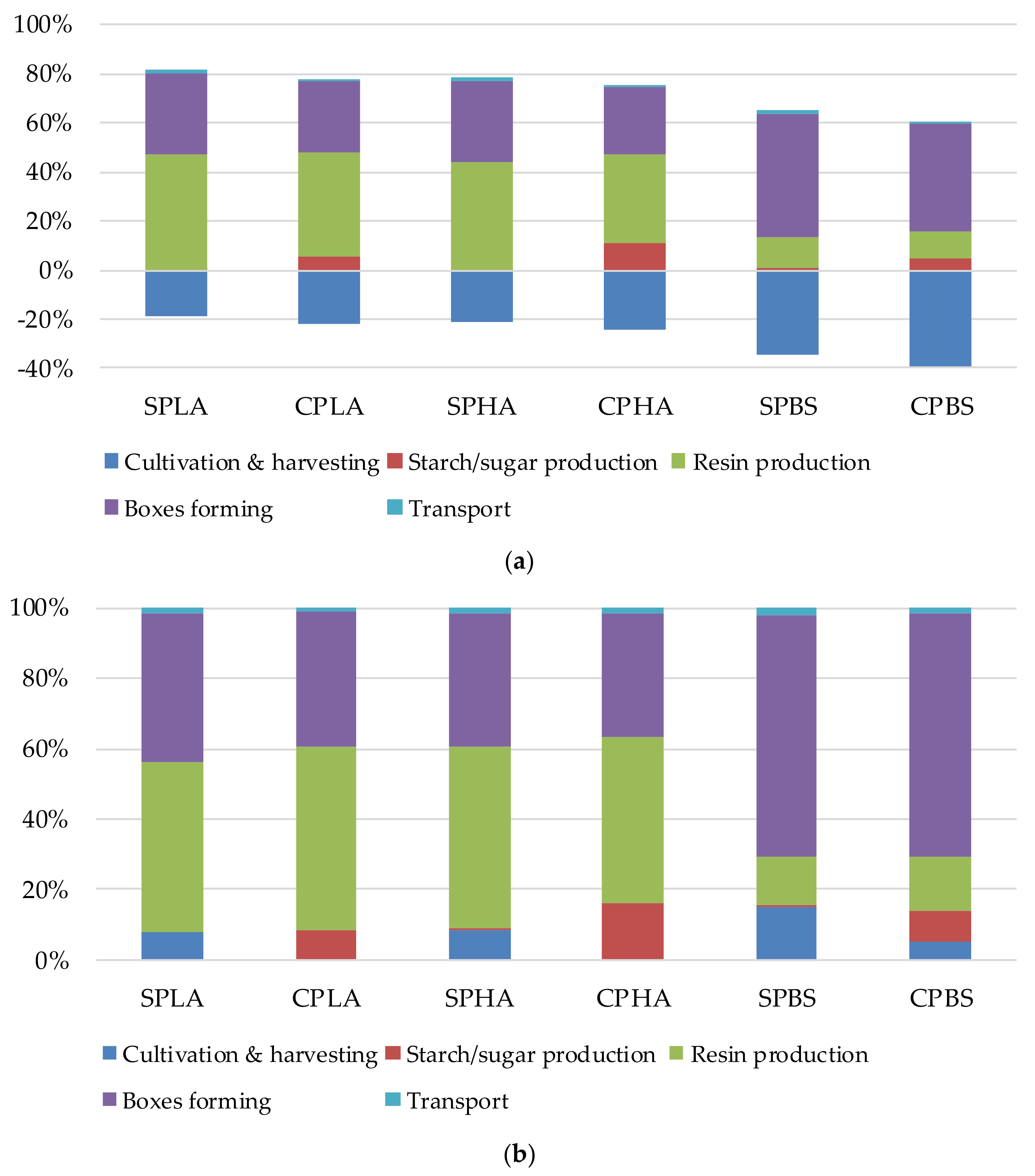Eco-Efficiency Assessment of Bioplastics Production Systems and End-of-Life Options
Abstract
:1. Introduction
2. Materials and Methods
2.1. Scope of the Study
2.2. Eco-Efficiency
2.3. Life Cycle Assessment
2.4. Economic Indicator
3. Results and Interpretation
3.1. Life Cycle Environmental Impacts
3.2. E/E of Bioplastic Production Systems
4. Discussion
5. Conclusions
Acknowledgments
Author Contributions
Conflicts of Interest
References
- Mitchell, A. Thinking without the ‘circle’: Marine plastic and global ethics. Political Geogr. 2015, 47, 77–85. [Google Scholar] [CrossRef]
- Gross, M. Oceans of plastic waste. Curr. Biol. 2015, 25, R93–R96. [Google Scholar] [CrossRef] [PubMed]
- Curran, M.A. Biobased materials. In Kirk-Othmer Encyclopedia of Chemical Technology; John Wiley & Sons Inc.: Hoboken, NJ, USA, 2000. [Google Scholar]
- Emadian, S.M.; Onay, T.T.; Demirel, B. Biodegradation of bioplastics in natural environments. Waste Manag. 2017, 59, 526–536. [Google Scholar] [CrossRef] [PubMed]
- European-Bioplastics. Bioplastics Market Data. Available online: http://www.european-bioplastics.org/market/ (accessed on 2 January 2018).
- Food and Agriculture Organization of the United Nations. Trade and Markets. Available online: http://www.fao.org/economic/est/est-commodities/en/#.Wls72KiWbIU (accessed on 2 January 2018).
- Bank of India. Thailand’s Bioeconomy Industry; Bank of India: Mumbai, India, 2017. [Google Scholar]
- Chen, G.Q.; Patel, M.K. Plastics derived from biological sources: Present and future: A technical and environmental review. Chem. Rev. 2012, 112, 2082–2099. [Google Scholar] [CrossRef] [PubMed]
- Shen, L.; Worrell, E.; Patel, M. Present and future development in plastics from biomass. Biofuels Bioprod. Biorefin. 2010, 4, 25–40. [Google Scholar] [CrossRef]
- Vink, E.T.H.; Davies, S. Life cycle inventory and impact assessment data for 2014 ingeo™ polylactide production. Ind. Biotechnol. 2015, 11, 167–180. [Google Scholar] [CrossRef]
- Groot, W.; Borén, T. Life cycle assessment of the manufacture of lactide and pla biopolymers from sugarcane in thailand. Int. J. Life Cycle Assess. 2010, 15, 970–984. [Google Scholar] [CrossRef]
- Papong, S.; Malakul, P.; Trungkavashirakun, R.; Wenunun, P.; Chom-in, T.; Nithitanakul, M.; Sarobol, E. Comparative assessment of the environmental profile of pla and pet drinking water bottles from a life cycle perspective. J. Clean. Prod. 2014, 65, 539–550. [Google Scholar] [CrossRef]
- Tecchio, P.; Freni, P.; De Benedetti, B.; Fenouillot, F. Ex-ante life cycle assessment approach developed for a case study on bio-based polybutylene succinate. J. Clean. Prod. 2016, 112, 316–325. [Google Scholar] [CrossRef]
- Khoo, H.H.; Tan, R.B.H.; Chng, K.W.L. Environmental impacts of conventional plastic and bio-based carrier bags. Int. J. Life Cycle Assess. 2010, 15, 284–293. [Google Scholar] [CrossRef]
- Suwanmanee, U.; Leejarkpai, T.; Mungcharoen, T. Assessment the environmental impacts of polylactic acid/starch and polyethylene terephthalate boxes using life cycle assessment methodology: Cradle to waste treatments. Int. J. Life Cycle Assess. 2013, 7, 259–266. [Google Scholar] [CrossRef]
- Khoo, H.; Tan, R.B.H. Environmental impacts of conventional plastic and bio-based carrier bags: Part 2: End-of-life options. Int. J. Life Cycle Assess. 2010, 15, 338–345. [Google Scholar] [CrossRef]
- Hottle, T.A.; Bilec, M.M.; Landis, A.E. Biopolymer production and end of life comparisons using life cycle assessment. Resour. Conserv. Recycl. 2017, 122, 295–306. [Google Scholar] [CrossRef]
- Madival, S.; Auras, R.; Singh, S.P.; Narayan, R. Assessment of the environmental profile of pla, pet and ps clamshell containers using lca methodology. J. Clean. Prod. 2009, 17, 1183–1194. [Google Scholar] [CrossRef]
- Tsiropoulos, I.; Faaij, A.P.C.; Lundquist, L.; Schenker, U.; Briois, J.F.; Patel, M.K. Life cycle impact assessment of bio-based plastics from sugarcane ethanol. J. Clean. Prod. 2015, 90, 114–127. [Google Scholar] [CrossRef]
- Suwanmanee, U.; Varabuntoonvit, V.; Chaiwutthinan, P.; Tajan, M.; Mungcharoen, T.; Leejarkpai, T. Life cycle assessment of single use thermoform boxes made from polystyrene (ps), polylactic acid, (pla), and pla/starch: Cradle to consumer gate. Int. J. Life Cycle Assess. 2013, 18, 401–417. [Google Scholar] [CrossRef]
- Chiarakorn, S.; Permpoonwiwat, C.; Nanthachatchavankul, P. Cost benefit analysis of bioplastic production in thailand. Econ. Public Policy 2011, 3, 44–73. [Google Scholar]
- ISO14045:2012. Environmental Management—Eco-Efficiency Assessment of Product Systems—Principles, Requirements and Guidelines; International Organization for Standardization: Geneva, Switzerland, 2012. [Google Scholar]
- Huppes, G.; Ishikawa, M. Eco-efficiency guiding micro-level actions towards sustainability: Ten basic steps for analysis. Ecol. Econ. 2009, 68, 1687–1700. [Google Scholar] [CrossRef]
- Ibbotson, S.; Dettmer, T.; Kara, S.; Herrmann, C. Eco-efficiency of disposable and reusable surgical instruments—A scissors case. Int. J. Life Cycle Assess. 2013, 18, 1137–1148. [Google Scholar] [CrossRef]
- Silalertruksa, T.; Gheewala, S.H.; Pongpat, P. Sustainability assessment of sugarcane biorefinery and molasses ethanol production in thailand using eco-efficiency indicator. Appl. Energy 2015, 160, 603–609. [Google Scholar] [CrossRef]
- Robaina-Alves, M.; Moutinho, V.; Macedo, P. A new frontier approach to model the eco-efficiency in european countries. J. Clean. Prod. 2015, 103, 562–573. [Google Scholar] [CrossRef] [Green Version]
- M-Tec. Thai National Life Cycle Inventory Database; M-Tec: Hahn, Spain, 2017. [Google Scholar]
- Wernet, G.; Bauer, C.; Steubing, B.; Reinhard, J.; Moreno-Ruiz, E.; Weidema, B. The ecoinvent database version 3 (part i): Overview and methodology. Int. J. Life Cycle Assess. 2016, 21, 1218–1230. [Google Scholar] [CrossRef]
- Pongpat, P.; Gheewala, S.H.; Silalertruksa, T. An assessment of harvesting practices of sugarcane in the central region of thailand. J. Clean. Prod. 2017, 142, 1138–1147. [Google Scholar] [CrossRef]
- Kawasaki, J.; Silalertruksa, T.; Scheyvens, H.; Yamanoshita, M. Environmental sustainability and climate benefits of green technology for bioethanol production in thailand. ISSAAS J. 2015, 21, 78–95. [Google Scholar]
- Silalertruksa, T.; Pongpat, P.; Gheewala, S.H. Life cycle assessment for enhancing environmental sustainability of sugarcane biorefinery in thailand. J. Clean. Prod. 2017, 140, 906–913. [Google Scholar] [CrossRef]
- Jakrawatana, N.; Pingmuangleka, P.; Gheewala, S.H. Material flow management and cleaner production of cassava processing for future food, feed and fuel in thailand. J. Clean. Prod. 2016, 134, 633–641. [Google Scholar] [CrossRef]
- Cheroennet, N.; Pongpinyopap, S.; Leejarkpai, T.; Suwanmanee, U. A trade-off between carbon and water impacts in bio-based box production chains in thailand: A case study of ps, plas, plas/starch, and pbs. J. Clean. Prod. 2017, 167, 987–1001. [Google Scholar] [CrossRef]
- Silalertruksa, T.; Gheewala, S.H. Environmental sustainability assessment of bio-ethanol production in thailand. Energy 2009, 34, 1933–1946. [Google Scholar] [CrossRef]
- Matarrese, P.; Fontana, A.; Sorlini, M.; Diviani, L.; Specht, I.; Maggi, A. Estimating energy consumption of injection moulding for environmental-driven mould design. J. Clean. Prod. 2017, 168, 1505–1512. [Google Scholar] [CrossRef]
- Pollution Control Department (PCD). The Draft of the Integrated Plastic Waste Management Plan (2017–2021); Pollution Control Department: Bangkok, Thailand, 2017.
- Ottawa Catholic School Board. The Project of Sugar and Sugarcane Preparedness for Bioplastic Industry; Ottawa Catholic School Board: Ottawa, ON, Canada, 2016. [Google Scholar]
- EPPO Electricity Tariff. Available online: http://www2.eppo.go.th/power/pw-Rate-PEA.html (accessed on 2 January 2018).
- WorldBank. What a Waste: A Global Review of Solid Waste Manafement; World Bank: Washington, DC, USA, 2012. [Google Scholar]
- Cost-Benefit Analysis of Recycling in the United States: Is Recycling Worth It? Available online: http://www.english.umd.edu/interpolations/2601 (accessed on 5 January 2018).
- Maine Technology Institute. The Business Case for Commercial Production of Bioplastics in Maine; Maine Technology Institute: Brunswick, ME, USA, 2010. [Google Scholar]
- PCA Labelling for Recyclability. Available online: http://www.pca.org.au/application/files/7014/3796/8256/Labellingdiscussionpaper.pdf (accessed on 13 March 2018).
- Kaewphan, N.; Gheewala, S.H. Greenhouse gas evaluation and market opportunity of bioplastic bags from cassava in thailand. J. Sustain. Energy Environ. 2013, 4, 5–19. [Google Scholar]








| Data | Source |
|---|---|
| Sugarcane cultivation and harvesting | Pongpat et al. [26] |
| Cassava cultivation and harvesting | Kawasaki et al. [27] |
| Sugar milling | Silalertruksa et al. [28] |
| Cassava starch production | Jakrawatana et al. [29] |
| Glucose production | Papong et al. [8] |
| PLA resin production | Groot and Boren [11] |
| PHAs resin production | Khoo et al. [10] |
| PBS resin production | Charoennet et al. [30] |
| PP resin production | ecoinvent 3 database |
| Molasses based ethanol production | Silalertruksa and Gheewala [31] |
| Cassava based ethanol production | Silalertruksa et al. [29] |
| Box forming | ecoinvent 3 database |
| Road transport | Thai national life cycle inventory database |
| Landfilling | European reference life cycle database |
| Composting | ecoinvent 3 database |
| Recycling | ecoinvent 3 database |
| Waste-to-energy incineration | European reference life cycle database |
| Electricity | Thai national life cycle inventory database |
| Chemicals | ecoinvent 3 database |
| Scenario | Type of Plastic | Disposal (Percentage) | |||
|---|---|---|---|---|---|
| Landfilling | Composting | Recycling | Incineration | ||
| Base case | PP | 75 | - | 25 | - |
| Scenario 1 | SPLA, CPLA, SPHAs, CPHAs, SPBS, CPBS | 70 | 30 | - | - |
| Scenario 2 | SPLA, CPLA, SPHAs, CPHAs, SPBS, CPBS | - | 100 | - | - |
| Scenario 3 | PP, SPLA, CPLA, SPHAs, CPHAs, SPBS, CPBS | - | - | 100 | - |
| Scenario 4 | PP, SPLA, CPLA, SPHAs, CPHAs, SPBS, CPBS | - | - | - | 100 |
| Item | Price/Cost |
|---|---|
| PP resin | 57 THB/kg |
| PLA resin | 93 THB/kg |
| PHAs resin | 170 THB/kg |
| PBS resin | 176 THB/kg |
| Electricity | 2.7 THB/kWh |
| Landfilling | 0.9 THB/kg |
| Composting | 0.8 THB/kg |
| Waste-to-energy incineration | 2.2 THB/kg |
| Recycling | 4.7 THB/kg |
| Scenario | Material | Environmental Impact (pt) | Environmental Impact Reduction (pt) | Cost (THB) | E/E (pt/THB) |
|---|---|---|---|---|---|
| Base case | PP | 1.83 × 10−10 | - | 2075 | - |
| Scenario 1 | SPLA | 2.13 × 10−10 | −3.01 × 10−11 | 4634 | −6.49 × 10−15 |
| CPLA | 2.36 × 10−10 | −5.35 × 10−11 | 4634 | −1.16 × 10−14 | |
| SPHA | 2.24 × 10−10 | −4.14 × 10−11 | 7720 | −5.36 × 10−15 | |
| CPHA | 2.35 × 10−10 | −5.20 × 10−11 | 7720 | −6.73 × 10−15 | |
| SPBS | 1.37 × 10−10 | 4.56 × 10−11 | 8110 | 5.63 × 10−15 | |
| CPBS | 1.40 × 10−10 | 4.29 × 10−11 | 8110 | 5.29 × 10−15 | |
| Scenario 2 | SPLA | 2.10 × 10−10 | −2.76 × 10−11 | 4631 | −5.97 × 10−15 |
| CPLA | 2.34 × 10−10 | −5.11 × 10−11 | 4631 | −1.10 × 10−14 | |
| SPHA | 2.22 × 10−10 | −3.91 × 10−11 | 7717 | −5.07 × 10−15 | |
| CPHA | 2.32 × 10−10 | −4.97 × 10−11 | 7717 | −6.44 × 10−15 | |
| SPBS | 1.37 × 10−10 | 4.56 × 10−11 | 8107 | 5.63 × 10−15 | |
| CPBS | 1.40 × 10−10 | 4.29 × 10−11 | 8107 | 5.29 × 10−15 | |
| Scenario 3 | PP | 8.24 × 10−11 | 1.00 × 10−10 | 2166 | 4.62 × 10−14 |
| SPLA | −8.56 × 10−11 | 2.68 × 10−10 | 4812 | 5.57 × 10−14 | |
| CPLA | −6.22 × 10−11 | 2.45 × 10−10 | 4812 | 5.09 × 10−14 | |
| SPHA | −5.63 × 10−11 | 2.39 × 10−10 | 7887 | 3.03 × 10−14 | |
| CPHA | −4.58 × 10−11 | 2.28 × 10−10 | 7887 | 2.90 × 10−14 | |
| SPBS | −1.48 × 10−10 | 3.30 × 10−10 | 8280 | 3.99 × 10−14 | |
| CPBS | −1.43 × 10−10 | 3.25 × 10−10 | 8280 | 3.93 × 10−14 | |
| Scenario 4 | PP | 2.04 × 10−10 | −2.11 × 10−11 | 2086 | −1.01 × 10−14 |
| SPLA | 1.89 × 10−10 | −6.14 × 10−12 | 4696 | −1.31 × 10−15 | |
| CPLA | 2.12 × 10−10 | −2.96 × 10−11 | 4696 | −6.31 × 10−15 | |
| SPHA | 2.02 × 10−10 | −1.89 × 10−11 | 7778 | −2.43 × 10−15 | |
| CPHA | 2.12 × 10−10 | −2.95 × 10−11 | 7778 | −3.79 × 10−15 | |
| SPBS | 1.14 × 10−10 | 6.85 × 10−11 | 8169 | 8.38 × 10−15 | |
| CPBS | 1.19 × 10−10 | 6.34 × 10−11 | 8169 | 7.76 × 10−15 |
© 2018 by the authors. Licensee MDPI, Basel, Switzerland. This article is an open access article distributed under the terms and conditions of the Creative Commons Attribution (CC BY) license (http://creativecommons.org/licenses/by/4.0/).
Share and Cite
Changwichan, K.; Silalertruksa, T.; Gheewala, S.H. Eco-Efficiency Assessment of Bioplastics Production Systems and End-of-Life Options. Sustainability 2018, 10, 952. https://doi.org/10.3390/su10040952
Changwichan K, Silalertruksa T, Gheewala SH. Eco-Efficiency Assessment of Bioplastics Production Systems and End-of-Life Options. Sustainability. 2018; 10(4):952. https://doi.org/10.3390/su10040952
Chicago/Turabian StyleChangwichan, Kunnika, Thapat Silalertruksa, and Shabbir H. Gheewala. 2018. "Eco-Efficiency Assessment of Bioplastics Production Systems and End-of-Life Options" Sustainability 10, no. 4: 952. https://doi.org/10.3390/su10040952






